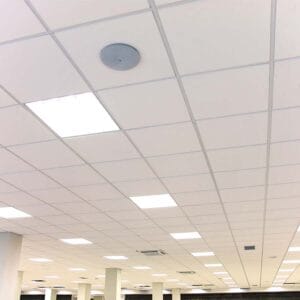Understanding Drop Ceilings & Ceiling Grids
 Homeowners and business owners are choosing drop ceilings, or suspended ceilings, more often. These ceilings work well in homes and businesses and they combine style and function perfectly.
Homeowners and business owners are choosing drop ceilings, or suspended ceilings, more often. These ceilings work well in homes and businesses and they combine style and function perfectly.
These innovative ceiling systems improve a room’s look and offer practical benefits. They enhance acoustics, provide better lighting options, and allow easy access to important plumbing and electrical systems hidden above.
In this article, we will look at drop ceilings. We will highlight their main benefits and how they differ from regular ceiling grids. If you are starting a renovation or want to improve your interior design, knowing about suspended ceilings is important. This knowledge helps you make smart choices for your space and your budget.
What is a Drop Ceiling?
A drop ceiling, also called a false ceiling or suspended ceiling, hangs below the main ceiling of a building. This creates a space between the two ceilings and provides several benefits:
- Aesthetics: A smooth, even surface enhances lighting, acoustics, and overall appearance.
- Accessibility: Easy access to concealed plumbing, electrical, and HVAC systems.
- Fire Safety: Incorporating fire-resistant materials and improving fire suppression systems is possible.
- Insulation: Enhancing thermal and acoustic insulation helps improve energy efficiency.
- Air Plenum: In Data Centres, the design of the void manages airflow by returning hot air to air handlers for cooling.
The Role of the Structural Ceiling Grid?
The structural ceiling grid is the main support for the drop ceiling and other structures above the floor. Composed of an interconnected metal framework, the structural grid affixes directly to the building’s main ceiling. It enables the attachment of infrastructure such as HVAC systems, cable management, power distribution systems, and the false ceiling.
Types of Ceiling Grids
A variety of ceiling grid types are available, including:
- Main Tee Grid: This well-known standard type has main tees that run lengthwise. It also has cross tees that connect them at right angles. The installation creates a familiar grid pattern. This makes it exceptionally versatile and compatible with many types and sizes of ceiling tiles.
- Concealed Grid: This simple option hides the grid for a cleaner look. It installs the grid behind the ceiling tiles, making it less noticeable.
- Exposed Grid: This type keeps the grid visible. It becomes part of the design and adds a visual element to the space.
- Specialty Grids: These grids meet special architectural needs. They can have unique shapes or sizes. Examples include curved grids, grids with built-in lighting, linear panels, or systems without grids.
Benefits of Using a Structural Ceiling Grid
Structural ceiling grids provide many benefits, including:
- Easy Installation and Maintenance: They allow for quick installation and easy access for repairs or replacements.
- Versatility: They are compatible with a wide range of ceiling tile types, including acoustic, fire-resistant, and decorative options.
- Strength and Durability: They provide a strong and reliable support system for the ceiling.
- Cost-Effectiveness: They offer a cost-effective solution for creating a finished ceiling.
Conclusion
Drop ceilings and structural ceiling grids offer many benefits. They can improve both the function and look of any room. If you want to hide flaws, improve sound, or enhance your space’s design, a drop ceiling is a good choice.
By knowing the differences between suspended ceilings and structural ceiling grids, you can make a better choice. This choice will meet your needs and match your style. Explore your options and discover how a suspended drop ceiling can transform your space today!



